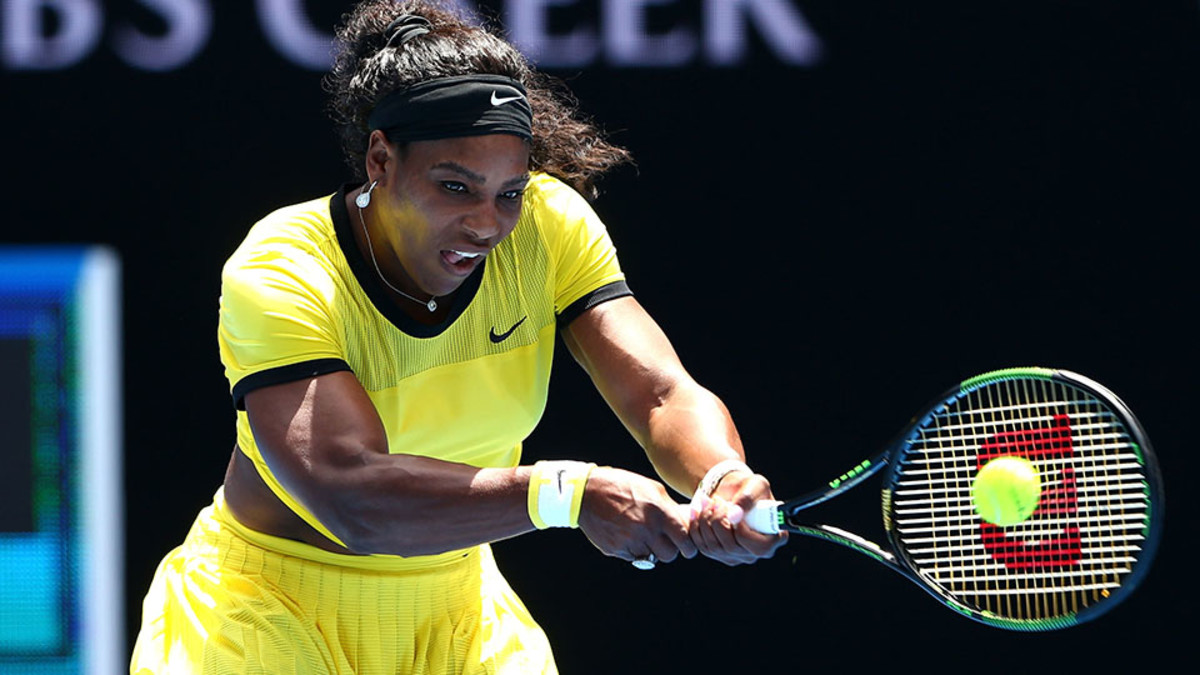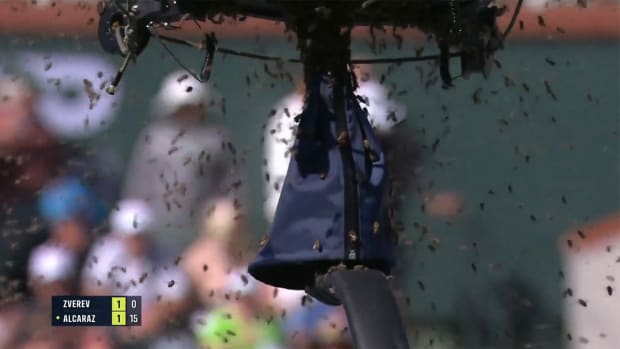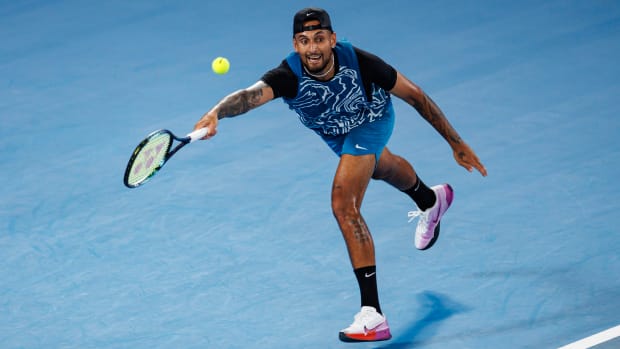
Serena Williams dispels doubts with opening win at Australian Open
MELBOURNE – For a player who resists convention as much as she does losing, leave it to Serena Williams to put herself in this unusual position: fresh from turning in an unsurpassed 2015—coming devastatingly close, of course, to pulling off the Grand Slam—she entered 2016 shrouded in questions, with plenty to prove. Since getting the business end of one of tennis’ great upsets, that U.S. Open semifinal defeat to Roberta Vinci, Serena had not played a sanctioned match before today. Her psyche had suffered a least a hairline fracture and needed time to recover. Same for her left knee, which has been in an extended state of rebellion.
On top of everything, the Tennis Fates did her no favors. In the first round of the 2016 Australian Open, Serena drew Camila Giorgi, a plucky and unpredictable Italian and the highest-ranked opponent Serena could possibly have faced. Last year Serena made it until September—spanning the globe, winning 26 matches—before losing at a major. As she left this morning to practice on Court 17, there was a concern, almost palpably so, that her bid to win the Grand Slam in 2016 could be thwarted on the first day of the first event.
Musings from Melbourne: Updates from Day 1 at 2016 Australian Open
That did not happen. Though far from her best, Serena prevailed 6–4, 7–5, her first win since the dethroning in Queens. In some ways, Serena was scarcely recognizable. Her claims notwithstanding, she was clearly slowed by that knee, failing to retrieve as she usually does, hitting only two more winners (19 to 17) than a much slighter opponent.
In other ways, this was vintage Serena. She did what she does best, hanging in the match, overcoming some loose patches and elevating her game when the situation demanded it. At 5-5 in the second set, Giorgi blinked, and Serena served out the match. We’ve seen this movie hundreds—literally, hundreds—of times before. (If we ever develop metric to quantify a player’s ability to summon their best stuff when it matters most, Serena’s GOAT credentials will be burnished still further.) If she projected relief, not elation, after the match, so be it. She was through to round two. Everything else was details.
In Melbourne, Serena Williams has mostly shined, occasionally struggled
Fans, media and other players all know how time works and it erodes even the best careers. So this sense of uneasiness about Serena’s prospects this year is, perhaps, to be expected. Still it seems a little harsh. She has won four of the last five majors and is 3:1 favorite to win the title. Victoria Azarenka hasn't been beyond the quarterfinals of a major in three years and is 7-2. Go figure.
Yes, Serena is 34 now. Yes, the pounding on her body is considerable and undeniable. Yes, objects in her rearview may be closer than they appear, players like Garbine Muguruza closing the distance perhaps. But Serena is still….well, Serena, and we probably ought to regard her as such. She doesn’t need to be at her best to win. The great ones seldom do.
Five thoughts from Day 1
• You wish there were more names and more of a sense of magnitude—and that might be a function of British defamation laws—but this story on match fixing caused quite a Day One ripple. Tennis administrators would do well to take this seriously. Technology + increased betting + the economics that give sub-50 players an incentive to dump = bad omen. We can talk about this more in coming days.
• You wouldn’t necessarily call it an “upset” but the elimination of Ivo Karlovic from the draw is significant. Suffering in the heat, he retired against Federico Delbonis.
• Want to fun player to watch? Check out Daria Gavrilova, a plucky Aussie who won today, beating Lucie Hradecka.
• Nice win for the American veteran Austin Krajicek, who took out Di Wu in straight sets.
• Tuesday's schedule: Madison Keys, Milos Raonic, Murguruza and Fabio Fognini-Gilles Muller start us at 11 a.m. local, 7 p.m. ET Monday. (From the good soldier department: Tennis Channel pre-game show starts at 10 a.m. in Melbourne, 6 p.m. ET.)
Quick Questions
I've always thought if a player enters a tournament the week before a Grand Slam event that player does not consider themselves a contender at the Grand Slam event.
—JB, Oregon
• That’s a bit harsh. But you’re point is well taken. I flew in Sunday from Sydney and sat a few rows from Viktor Troicki, who had just won the title. I’m thinking: good for him. But how is he going to play his best when he arrives at a major less than a day before first ball? This is always the issue with these tune-ups. The players want some prep work. But a) the best players aren’t taking matches and risking/fatigue before the event. B) other players are withdrawing at the drop of a visor—and in the case of Bernard Tomic, they’re unapologetic about it.
Here's what the top players will wear on court at the 2016 Australian Open
I learned to play doubles from watching Hingis/Kournikova. Been a Hingis fan ever since. Do you think Hingis/Mirza are as good or better than Hingis/Kournikova? Will Hingis/Mirza replace Hingis/Kournikova as the All-Time leaders in winning percentage in the Open era?
My impression is the Mirza combination is not yet as good. 1) Hingis won 11 titles with each. With Kournikova, Hingis only lost five matches (most of them when one of them had a nagging injury). With Mirza, Hingis has lost seven matches. 2) When watching the Kournikova version, it always seemed like the duo was going to win. When watching the Mirza version I lack confidence in the outcome.
—Jerry White, The villages, Fla.
• Interesting question. What’s that sound I hear? Ah, right, the siren song of the recency bias. Unable to resist, I say Hingis-Mirza. Quite apart from the records, I think they’re simply a better team. Two players wholly committed to the team—as opposed to shifting allegiances between the partnership and their top-tier singles careers—who have a certain emotional maturity. (Hingis and Mirza have a combined age approaching 70. Kournikova and Hingis had a combined age around 40).
You could assert that more top players combined alongside partners during the Hingis-Kournikova era. The Williams sisters, Lindsay Davenport, Jana Novotna, etc.
2016 Australian Open roundtable: Predictions, dark horses and more
But two points. 1) Jerry’s question gives us an opportunity to try and erode an annoying tennis myth: that Kournikova was some counterfeit player. The truth is, she was not only excellent but could play anywhere on the court. She was as good as they came in doubles; a top singles player; and her inability to win a title was as much a function of her being forced by WTA rules to play only the top events on account of her marketability.
2) Can we agree on this? Hingis-Mirza comes with less psychodrama. Oh, to have been a mosca on the wall when they both asserted, “I am the queen.”
Jon, isn't it obvious that with slower courts and longer rallies, we will see more player injuries? If the ball doesn't travel quickly through the court, it's up to the player to generate the force required to get the ball past an opponent. That, in addition to longer rallies, and more windup on every shot due to the changes in string technology, is why we are seeing more injuries.
—Rob, Fairfax, Va.
Serena Williams not worried about injury, or what lies ahead
• Sounds reasonable. But so does string technology that encourages overhitting. And too abrupt transitions from surface to surface. And even six-games sets. The point is: what is being done to address this? Chris Clarey nailed it here.
Pompitous: A word of failed coinage originally intended to mean a sound that, when invoked in connection with the word "love" causes some people to call the person who did said invoking "Maurice." I love that you understand the importance of veering entirely off the topic of tennis to take on issues like Steve Miller and the Hall of Fame. It keeps everything in perfect perspective. Thank you!
—John H. Campbell, Portland, Ore.
• “Well, I ain't superstitious
And I don't get suspicious
But my woman is a friend of mine
And I know that it's true that all the things that I do
Will come back to me in my sweet time”
Shots, Miscellany
• Tip of the Ballcap to Mardy Fish.
• For as much as we discuss Djokovic’s modest profile, he’s all over Australia:
[youtube=https://www.youtube.com/watch?v=jLnYSMdWAyc]
• Long Lost Siblings: Ernests Gulbis and Ray Ploshansky of Girls.





